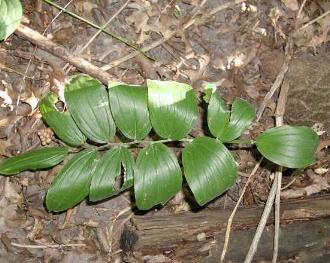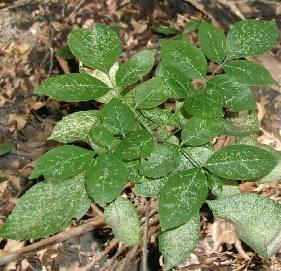|
There are wide, extensive
varieties of wild flowers in Minnesota. The large diversity that
exists here is a consequence of the variable landscape.
In the Oak woodland of the
ARCC natural area, there are wild flowers that have green, soft stems or
hard, woody stems. Some are perennials, others are annuals or
biennials, which last for only one year or two respectively. Also,
non-native wild flowers are often found because of disturbed land and
seeds from farms or gardens. These flowers have now become
naturalized here because of the specific variables in the soil, wind and
temperature of the oak woodland that they inhabit. The dry, shaded
areas of the Oak woodland provides adequate habitat for a variety of
flowers.

False Solomon's
seal Polygonatum racemosa
False Solomon's
seal are found in clearings in a forest. They flower from
April to July and their flowers are creamy-white, in an elongate,
frothy, terminal cluster. They have oval pointed leaves
alternating along an arching stem.
The young
shoots can be added to salads or prepared like asparagus.

Wild
sarsaparilla
Aralia nudicaulis
Wild
sarsaparilla, is a
rhizomatous perennial. This means that it has buds that produce
shoots and will usually last at least 3 seasons. Early settlers
used to use the rhizome of this herb to make a form of root beer.
In the late spring-early
summer, tiny green-white flowers will appear. The flowers are
usually found in a clump of 3 on top of the leafless stalk.
Purple-black berries appear in clusters soon after and are edible, but
not palatable. The useful part of this herb for humans is said to
be the roots which can be used as a tonic, diuretic, or a cleansing herb
that lowers fever. The root has also been taken internally for
coughs or externally for boils, arthritis, and swellings.
The wild
sarsaparilla is common across much
of North America, especially in dry to moist forests.
Unfortunately, it is not as common in the wet, moist lands of the
coniferous forest.
Back
Author: Laurie Hanson, Kerry Dennison, and
Melissa Minter. October 2001.
© 2013 Anoka-Ramsey Community College - Biology Department.
The contents of this page have not been reviewed by ARCC.
Last Updated -July 28, 2016
Comments or Problems contact:
Melanie Waite-Altringer or
Joan McKearnan or
Terry Teppen
|